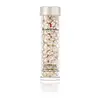What's inside
What's inside
 Key Ingredients
Key Ingredients

 Benefits
Benefits

 Concerns
Concerns

 Ingredients Side-by-side
Ingredients Side-by-side

Dimethicone
EmollientCaprylic/Capric Triglyceride
MaskingDimethicone/Vinyltrimethylsiloxysilicate Crosspolymer
Silica
AbrasiveEthylhexyl Palmitate
EmollientC12-15 Alkyl Benzoate
AntimicrobialDimethiconol
EmollientButylene Glycol
HumectantCeramide Ng
Skin ConditioningCeramide NP
Skin ConditioningCeramide Ns
Skin ConditioningCyclopentasiloxane
EmollientDiethylhexyl Syringylidenemalonate
Skin ProtectingEthylhexyl Cocoate
EmollientHelianthus Annuus Seed Oil
EmollientHydrogenated Castor Oil
EmollientHydrolyzed Sodium Hyaluronate
Skin ConditioningLactic Acid
BufferingLecithin
EmollientOlea Europaea Fruit Oil
MaskingPalmitoyl Hexapeptide-12
Skin ConditioningPEG-10 Phytosterol
EmulsifyingPentylene Glycol
Skin ConditioningPersea Gratissima Oil
Skin ConditioningPhytosphingosine
Skin ConditioningPhytosterols
Skin ConditioningPropylene Glycol Dicaprylate/Dicaprate
EmollientRicinus Communis Seed Oil
MaskingSilica Dimethyl Silylate
EmollientSodium Hyaluronate
HumectantTribehenin
EmollientZingiber Zerumbet Extract
Skin ConditioningPhenoxyethanol
PreservativeDimethicone, Caprylic/Capric Triglyceride, Dimethicone/Vinyltrimethylsiloxysilicate Crosspolymer, Silica, Ethylhexyl Palmitate, C12-15 Alkyl Benzoate, Dimethiconol, Butylene Glycol, Ceramide Ng, Ceramide NP, Ceramide Ns, Cyclopentasiloxane, Diethylhexyl Syringylidenemalonate, Ethylhexyl Cocoate, Helianthus Annuus Seed Oil, Hydrogenated Castor Oil, Hydrolyzed Sodium Hyaluronate, Lactic Acid, Lecithin, Olea Europaea Fruit Oil, Palmitoyl Hexapeptide-12, PEG-10 Phytosterol, Pentylene Glycol, Persea Gratissima Oil, Phytosphingosine, Phytosterols, Propylene Glycol Dicaprylate/Dicaprate, Ricinus Communis Seed Oil, Silica Dimethyl Silylate, Sodium Hyaluronate, Tribehenin, Zingiber Zerumbet Extract, Phenoxyethanol
Water
Skin ConditioningCyclopentasiloxane
EmollientDimethicone
EmollientPolysilicone-11
Isododecane
EmollientButylene Glycol
HumectantAscorbyl Glucoside
AntioxidantPEG-10 Dimethicone
Skin ConditioningPEG-6
HumectantMorus Bombycis Root Extract
Skin ConditioningScutellaria Baicalensis Root Extract
AstringentCamellia Sinensis Leaf Extract
AntimicrobialCucumis Sativus Fruit Extract
EmollientSaccharomyces Lysate Extract
HumectantHordeum Vulgare Extract
EmollientSalicylic Acid
MaskingTriticum Vulgare Germ Extract
Skin ConditioningCholesterol
EmollientOryza Sativa Bran Extract
Skin ConditioningSqualane
EmollientAcetyl Glucosamine
Skin ConditioningSodium Hyaluronate
HumectantCaffeine
Skin ConditioningIsohexadecane
EmollientBetula Alba Bark Extract
MaskingTrametes Versicolor Extract
Sodium Rna
Skin ConditioningGlycyrrhetinic Acid
Skin ConditioningDimethoxytolyl Propylresorcinol
AntioxidantDi-C12-18 Alkyl Dimonium Chloride
Skin ConditioningHelianthus Annuus Seedcake
AbrasiveYeast Extract
Skin ConditioningCaprylyl Glycol
EmollientPropylene Glycol Dicaprate
EmollientAmmonium Acryloyldimethyltaurate/Vp Copolymer
Acrylamide/Sodium Acryloyldimethyltaurate Copolymer
Emulsion StabilisingPolysorbate 20
EmulsifyingTocopheryl Acetate
AntioxidantPolysorbate 80
EmulsifyingTromethamine
BufferingSodium Hydroxide
BufferingHexylene Glycol
EmulsifyingDisodium EDTA
Sodium Benzoate
MaskingSodium Metabisulfite
AntioxidantSodium Sulfite
PreservativePhenoxyethanol
PreservativeCI 15985
Cosmetic ColorantCI 19140
Cosmetic ColorantWater, Cyclopentasiloxane, Dimethicone, Polysilicone-11, Isododecane, Butylene Glycol, Ascorbyl Glucoside, PEG-10 Dimethicone, PEG-6, Morus Bombycis Root Extract, Scutellaria Baicalensis Root Extract, Camellia Sinensis Leaf Extract, Cucumis Sativus Fruit Extract, Saccharomyces Lysate Extract, Hordeum Vulgare Extract, Salicylic Acid, Triticum Vulgare Germ Extract, Cholesterol, Oryza Sativa Bran Extract, Squalane, Acetyl Glucosamine, Sodium Hyaluronate, Caffeine, Isohexadecane, Betula Alba Bark Extract, Trametes Versicolor Extract, Sodium Rna, Glycyrrhetinic Acid, Dimethoxytolyl Propylresorcinol, Di-C12-18 Alkyl Dimonium Chloride, Helianthus Annuus Seedcake, Yeast Extract, Caprylyl Glycol, Propylene Glycol Dicaprate, Ammonium Acryloyldimethyltaurate/Vp Copolymer, Acrylamide/Sodium Acryloyldimethyltaurate Copolymer, Polysorbate 20, Tocopheryl Acetate, Polysorbate 80, Tromethamine, Sodium Hydroxide, Hexylene Glycol, Disodium EDTA, Sodium Benzoate, Sodium Metabisulfite, Sodium Sulfite, Phenoxyethanol, CI 15985, CI 19140
 Reviews
Reviews

Ingredients Explained
These ingredients are found in both products.
Ingredients higher up in an ingredient list are typically present in a larger amount.
Butylene Glycol (or BG) is used within cosmetic products for a few different reasons:
Overall, Butylene Glycol is a safe and well-rounded ingredient that works well with other ingredients.
Though this ingredient works well with most skin types, some people with sensitive skin may experience a reaction such as allergic rashes, closed comedones, or itchiness.
Learn more about Butylene GlycolCyclopentasiloxane, or D5, is a silicone used to improve texture of products and trap moisture.
D5 is considered lightweight and volatile. Volatile means it evaporates quickly after application. Once evaporated, D5 leaves a thin barrier that helps keep skin hydrated.
It is also an emollient. Emollients help soften the skin and prevent water loss. Silicones create a silky texture in products. D5 helps other ingredients become more spreadable.
Studies show D5 is safe to use in skincare products. We recommend speaking with a skincare professional if you have concerns.
Learn more about CyclopentasiloxaneDimethicone is a type of synthetic silicone created from natural materials such as quartz.
What it does:
Dimethicone comes in different viscosities:
Depending on the viscosity, dimethicone has different properties.
Ingredients lists don't always show which type is used, so we recommend reaching out to the brand if you have questions about the viscosity.
This ingredient is unlikely to cause irritation because it does not get absorbed into skin. However, people with silicone allergies should be careful about using this ingredient.
Note: Dimethicone may contribute to pilling. This is because it is not oil or water soluble, so pilling may occur when layered with products. When mixed with heavy oils in a formula, the outcome is also quite greasy.
Learn more about DimethiconePhenoxyethanol is a preservative that has germicide, antimicrobial, and aromatic properties. Studies show that phenoxyethanol can prevent microbial growth. By itself, it has a scent that is similar to that of a rose.
It's often used in formulations along with Caprylyl Glycol to preserve the shelf life of products.
Sodium Hyaluronate is hyaluronic acid's salt form. It is commonly derived from the sodium salt of hyaluronic acid.
Like hyaluronic acid, it is great at holding water and acts as a humectant. This makes it a great skin hydrating ingredient.
Sodium Hyaluronate is naturally occurring in our bodies and is mostly found in eye fluid and joints.
These are some other common types of Hyaluronic Acid:
Learn more about Sodium Hyaluronate